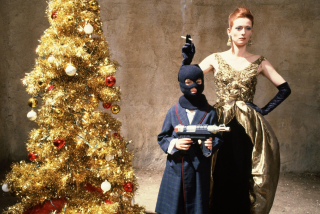Academy of Motion Picture Arts and Sciences re-creates moviegoing experience of 100 years ago
- Share via
Films may have been silent a century ago, but the film projectors weren’t.
Back in 1909, projectionists would stand in the middle of a venue and hand crank 10-minute one-reelers. Some moviegoers would even sit near the projector because they liked the intermittent click-click sound of the cranking.
The Academy of Motion Picture Arts and Sciences is re-creating the sights and the sounds of the moviegoing experience 100 years ago with its “A Century Ago: The Films of 1909 -- The Stars Are Born” on Monday evening and “A Century Ago: The First Films of Mary Pickford” on Tuesday. Both events take place at the Linwood Dunn Theater.
Besides Michael Mortilla’s live accompaniment to these vintage films, Joe Rinauldo will be hand-cranking the movies on a restored 1909 Nicholas Power Co. Model 6 Cameragraph.
Throughout the silent era, projectionists hand-cranked film. “It was an art of pride,” says Rinauldo. “A lot of these itinerant projectionists would travel to towns that didn’t have theaters. They would usually travel in a wagon or old truck, bring a piano and would set up tent shows.”
And it was a real skill to crank correctly. “The frame rate is kind of a tricky thing,” says Rinauldo, who fell in love with old films as a boy.
“The mean speed was around 16 frames a second. One turn of the crank handle is 16 frames with one crank equaling one second. Movie cameramen would hum ‘The Anvil Chorus’ in their mind to keep their speed even. But often cameramen wouldn’t hold their speed and different cameramen would film a scene.”
So just as 100 years ago, Rinauldo adjusts his cranking to correct any problems with the frame speed.
Rinauldo will be projecting an eclectic mixture of films both nights, including early films of comic Ben Turpin and stage star Maurice Costello.
For the last seven years, academy programmer Randy Haberkamp has been presenting the “A Century Ago” programs, which offers a fascinating look at the advances movies made during the art form’s early days. Haberkamp notes that 1909 was a particularly significant year.
“This is the year that the films really stopped looking like film theater and started looking like movies with more editing and different locations,” says Haberkamp.
Though he wasn’t getting credit yet for his films, when director D.W. Griffith joined Biograph Studios in 1908, it shook things up creatively.
Studios also began leaving New York and New Jersey to make films in Los Angeles in 1909. By year’s end, “several dozen movies had been shot out here -- westerns and jungle pictures,” says Haberkamp. “People were looking for more exotic locales and they quickly noticed the look of these films. It was very popular to have these rugged mountainsides and horses on ranges and deserts as opposed to the New Jersey western.”
Films were still one-reelers in which an entire story had to be told in just 10 minutes. But Griffith would play with the standardized formula.
“Sometimes, he would have the whole scene shot as a single take,” says Haberkamp. “Other times he would cross cut between locales.”
Audiences also were beginning to take notice of certain performers, such as Pickford, Florence Lawrence, Lionel Barrymore, Turpin, Max Linder and Bronco Billy Anderson.
The seminal film in Monday’s program is Griffith’s “A Corner in Wheat” based on a Frank Norris novel. Griffith deftly used the cross-cut editing style in this morality tale of a “farmer sowing his oats intercut with this story of this guy cornering the market on wheat,” Haberkamp says. “For its time, it’s an incredibly complex film and takes on a social issue directly.”
Griffith is also the director of all eight films in the Pickford program Tuesday night. The Library of Congress’ Christel Schmidt will be the host.
Before she became “America’s Sweetheart,” Pickford was a 17-year-old theater actress from Canada looking for her next gig. It was her actress mother who suggested that she try her luck at Biograph Studios in New York City.
“Mary was horrified because she was a theater actress,” says Schmidt. But the petite actress went to Biograph and entranced Griffith.
Five of the films in the program have been restored by the Library of Congress -- Pickford donated her film collection to the Library of Congress in 1946 -- and three of those restorations are making their premieres: “To Save Her Soul,” “The Mountaineer’s Honor” and “A Midnight Adventure.”
Pickford got in a memorable knock-down-drag-out fight with Griffith while making “To Save Her Soul.”
“Griffith wanted her in a particularly tense scene to give a better performance,” says Schmidt. “They had a huge row, which led him to poke her and she fell. Her sister Lottie attacked him and then she attacked him. She was a lot like that kind of spicy, fiery character that you see on screen.”
For information go to www.oscars.org
More to Read
Only good movies
Get the Indie Focus newsletter, Mark Olsen's weekly guide to the world of cinema.
You may occasionally receive promotional content from the Los Angeles Times.










